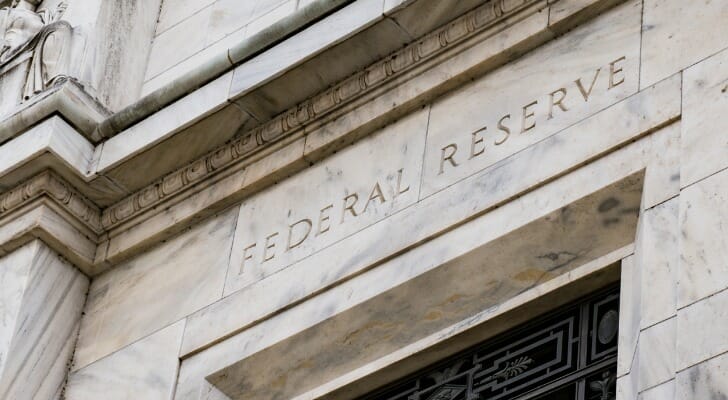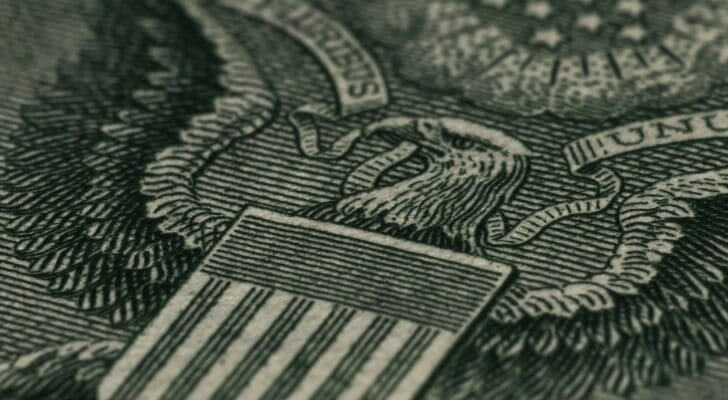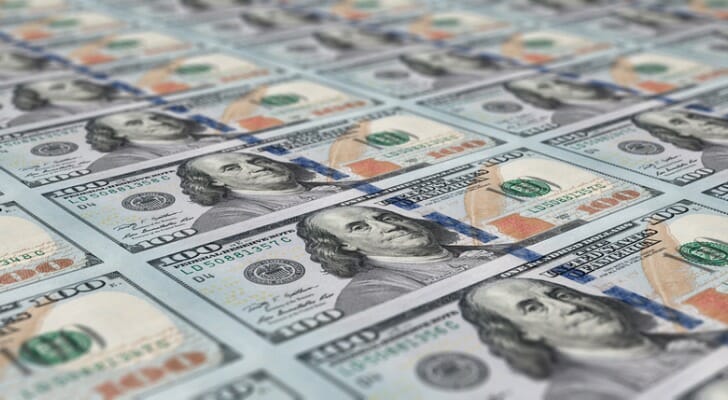You most likely heard about quantitative easing during the Great Recession. With talk of recession more common recently, you will likely hear about it again. Quantitative easing is when central banks use newly printed money to purchase large numbers of securities. Here’s how it works and what it does.
Understanding economics and central bank activity can improve your ability to handle money. A financial advisor can help you apply monetary policy to your investing and saving.
Quantitative Easing Defined
Quantitative easing is when central banks, like the Federal Reserve, use newly printed money to purchase large numbers of securities from the private market. This is a liquidity measure that they use to fight economic downturns. It also tries to make borrowing cheaper in order to help an economy grow again. It’s part of what economists call “extraordinary measures” because policymakers don’t typically use it when responding to a recession.
However, extraordinary became ordinary in recent years. Far from a niche concept recognized only by macroeconomists, quantitative easing is increasingly common. That could be a very big problem.
Quantitative easing is an extension of the Federal Reserve’s routine revenue generation. The central bank is a self-funded institution, which is why it is referred to as independent within the government. It raises funds primarily by purchasing government securities and making money off the interest payments. During quantitative easing, the bank increases that process significantly. It purchases securities not based on how much revenue the bank will need but based on how much liquidity it wants to put into the marketplace.
What Is Liquidity?
In economic terms, liquidity refers to how easily you can access money in the marketplace. It measures how easily buyers can get capital when they want to buy something. Similarly it indicates easily sellers can find buyers with sufficient capital to buy their products.
Liquidity doesn’t just refer to the amount of capital that exists in the market. Arguably more often, it refers to how easily buyers and sellers can access that capital.
For example, a situation in which banks will not lend money on terms that people can afford is considered a liquidity problem. The market has would-be buyers (borrowers) and sufficient capital (the cash held by the bank), but insufficient access to it the latter (the banks will not lend on terms the buyers can or will meet). The result would lead to an economic slowdown as businesses lose income.
Consumer spending can affect liquidity as well. When consumers try to spend less and keep their money in savings, businesses lose customers and economic growth slows. Low consumer spending paired with low interest rates is typically known as a “liquidity trap.” In other words, the mechanism that should get those consumers off the sidelines and into the market has failed.
Keeping liquidity high enough to maintain economic activity yet low enough to avoid inflation is one of government’s toughest jobs.
What Is the Federal Reserve?

Most modern economies have some version of what’s known as a “central bank.” This is an institution either run by or affiliated with the national government that performs many macroeconomic functions, such as setting interest rates on government borrowing and determining how much currency to keep in circulation. In the United States that institution is the Federal Reserve.
The Federal Reserve has a dual mandate. Its mission is to minimize unemployment while keeping inflation low. Congress has charged the Federal Reserve with balancing these two forces through what’s known as “monetary policy.” This is the practice of manipulating the supply of and access to money in an economy.
The Federal Reserve does this is by increasing or decreasing the amount of currency in circulation. It also sets the federal funds interest rate, more commonly known as “the Fed” or just “interest rates.”
The federal funds rate is the rate at which deposit banks lend each other money overnight. They do so in order to comply with federal regulations. The government says banks must keep a certain percentage of depositor’s money on hand in cash reserves. Banks borrow this money on a routine basis. As a result, the federal funds rate either influences or sets a minimum for all interest rates across the country.
By lowering its interest rates, the Federal Reserve can cause banks to lower interest rates on almost all lending from mortgages and credit cards to small business loans. This increases liquidity, making it more likely that people will engage in economic activity, whether buying a house, shopping for a TV or opening a store, driving up employment.
That doesn’t always work though.
Zero Lower Bounds
When the Federal Reserve cuts interest rates to zero or near-zero, this is called the “zero lower bound.” It is sometimes called the ZIRP, or “zero interest rate policy.”
This is ordinarily a rare event for a central bank and is meant as a response only to particularly dire circumstances. During the 20th century the Federal Reserve only cut its interest rates below 1% twice, for no longer than three months each time.
For example, between 1970 and 1980, the Federal Reserve’s interest rates fluctuated between 3.29% at the lowest and 17.61% at the highest. Operating within this range of interest rates gives a central bank significant room to move. With higher interest the economic normal, the central bank can cut rates and expect that the economy will respond.
By contrast in the 21st century the Federal Reserve has kept interest rates below 2% for three continuous years, from December, 2001 until December, 2004. In November, 2008 the Federal Reserve lowered rates to zero and kept them there for nearly eight years. It has not climbed above 2.5% since.
This has caused significant concern among economists because it leaves the Federal Reserve with little that it can do to help improve employment. Simply put, how can the bank cut interest rates that are already at zero?
Concerns With Quantitative Easing
As with all measures that increase liquidity this runs the risk of increasing inflation. It is unlikely that this will happen with first driving increased employment, but simultaneous inflation and recession are not impossible. This is known as stagflation.
Further, quantitative easing assumes a potential marketplace. Consumer demand generally defines capitalist economies. Businesses tend to spend in response to either existing or perceived opportunities for new customers. Recessions are marked, more than anything else, by a collapse in demand as consumers lose their jobs. As a result, businesses lose customers.
Quantitative easing is that it does not address this issue. It makes lending cheaper for banks, but does not create any new incentives for borrowing. Businesses still don’t have customers, so don’t need to spend on equipment or expansion. Consumers still fear for their jobs, so are reluctant to take on new debt. As a result, much of the data from the Great Recession suggests that quantitative easing mainly increased the supply of capital held by banks. They were more likely to hold on to the new money than lend it out.
Fiscal vs. Monetary Policy
In addition to questions about its effectiveness, many politicians and economists unfavorably compare the Federal Reserve’s monetary policies against what is known as “fiscal policy.” This manages the economy through taxing and spending.
Most mainstream economists agree that the most effective response to economic recessions is through fiscal policy. In extremely simplified form, this line of reasoning argues that the government should be a “spending of last resort” during recessions. It makes up the economic activity that the private sector isn’t generating through its own employment and spending. This can break the negative feedback loop of low liquidity and personal fear that tends to drive a recession by putting money directly into the pockets of consumers and businesses. Once growth returns, government should shift its attention from spending to paying down debts.
One of the biggest bottlenecks for fiscal policy is paying for this increased spending. When the government increases spending, it traditionally has to borrow money or raise taxes in order to generate the revenue for that spending. Both of these measures have their own problems that can potentially slow economic growth.
Some critics of quantitative easing argue that this is how the government should put new money into the market. Instead of using taxes or borrowing to raise revenue for fiscal policy, Congress and the Federal Reserve should use fiscal policy to put new money out into the market.
The Bottom Line

During quantitative easing, the Federal Reserve buys large numbers of securities on the private market. Typically, if not exclusively, the central bank buys government securities such as treasury notes and bonds. Also typically it purchases these securities from deposit banks and other lending institutions.
The goal of quantitative easing is to create liquidity by making money more common and, therefore, cheaper. By giving banks access to more capital, the central bank hopes that they feel more confident and lower interest rates and increase lending. This in turn will allow consumers and businesses to borrow money and conduct business, increasing the rate of commerce and economic growth overall.
Economic Tips
- Consider working with a financial advisor. If you don’t have a financial advisor yet, finding one doesn’t have to be hard. SmartAsset’s free tool matches you with up to three vetted financial advisors who serve your area, and you can interview your advisor matches at no cost to decide which one is right for you. If you’re ready to find an advisor who can help you achieve your financial goals, get started now.
- It’s not just the Federal Reserve dictating monetary policy. The states run their own massive stimulus policies called lotteries. This is… not the best way to help an economy. Meanwhile, the U.S. prison system manages more money than half the nations in the world. Here’s how.
Photo credit: ©iStock.com/eranicle, ©iStock.com/pabradyphoto, ©iStock.com/DKart
